Penjikent murals
The murals of Penjikent are among the most famous murals of the pre-Islamic period in Panjakent, ancient Sogdiana, in Tajikistan. Numerous murals were recovered from the site, and many of them are now on display in the Hermitage Museum in Saint Petersburg, and in the National Museum of Antiquities of Tajikistan in Dushanbe.
| Penjikent murals | |
|---|---|
.jpg.webp) Penjikent mural in the Hermitage Museum, Saint Petersburg. | |
| Created | 5th century - 722 CE |
| Discovered | Panjakent, Tajikistan 39.486792°N 67.620477°E |
| Present location | Hermitage Museum, National Museum of Antiquities of Tajikistan |
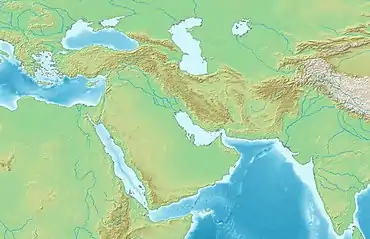 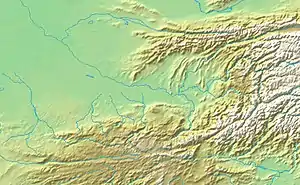 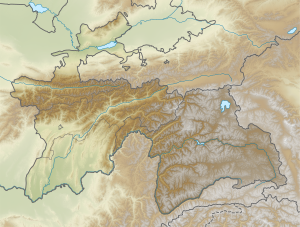 | |
The murals of Penjikent are the earliest known Sogdian murals, starting from the late 5th to early 6th century CE, and are preceded by the Hepthalite murals of Tukharistan as seen in Balalyk Tepe, from which they received iconographical and stylistic influence.[1] Also visible is a great variety of influences: Greek decorative styles encounter the Iranian narratives of the Shahnameh and the epic cycle of Rostam, scenes of festivities alternate with depictions of combats, local cults mix with Iranian and Indian deities.
The production of paintings started in the end of the 5th century CE and stopped in 722 CE with the invasion of the Abbasid Caliphate, in the Muslim conquest of Transoxiana, and many works of art were damaged or destroyed at that time.[2][3][4]
Festivites
Scenes of festivities abound in the murals.[2][3][4]
.jpg.webp) Men banquet, pigment on plaster. Pendjikent, Tajikistan
Men banquet, pigment on plaster. Pendjikent, Tajikistan.jpg.webp) Panjakent (Panjīkant) mural, 6th-8th centuries
Panjakent (Panjīkant) mural, 6th-8th centuries
Rostam cycle
The Iranian narrative of the Shahnameh and the epic cycle of Rostam are among the most important series of mural at Penjikent. They are mainly hosted in the Hermitage Museum, Hall 49.[2][3][4]
Rostam is shown in numerous activities and battles, both against human and mythical opponents. The Iranian hero Rostam, mythical king of Zabulistan, is shown with an elongated skull in his 7th century CE mural at Panjikent. This choice follows from the emblematic look of the Alchon Huns, who ruled in that same area until the 7th century CE.[5][6][7]

Details
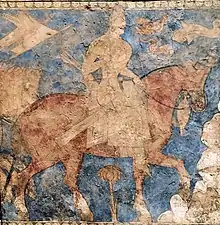 Rostam, with an elongated skull.
Rostam, with an elongated skull..jpg.webp) Panjikent mural (6th-7th century CE). Hermitage Museum
Panjikent mural (6th-7th century CE). Hermitage Museum_mural_%252C_6th-8th_Centuries_(2).jpg.webp) Panjakent (Panjīkant) mural, 6th-8th centuries. Hermitage Museum
Panjakent (Panjīkant) mural, 6th-8th centuries. Hermitage Museum_mural_%252C_6th-8th_Centuries.jpg.webp) Panjakent (Panjīkant) mural, 6th-8th centuries. National Museum of Antiquities of Tajikistan
Panjakent (Panjīkant) mural, 6th-8th centuries. National Museum of Antiquities of Tajikistan
Religion
Local cults mix with Iranian and Indian deities.[2][3][4]
 Penjikent, figures with halos, first half of the 8th century. Sector XXIV. Chamber 1. Hermitage Museum
Penjikent, figures with halos, first half of the 8th century. Sector XXIV. Chamber 1. Hermitage Museum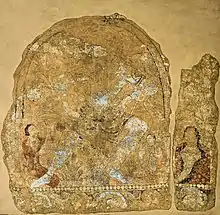
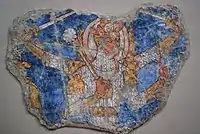 Multi-armed deity in armour: "A King of the Demons". Room 19/ Sector XXVI. 8th century CE.[8]
Multi-armed deity in armour: "A King of the Demons". Room 19/ Sector XXVI. 8th century CE.[8].jpg.webp) Deity. Hermitage Museum
Deity. Hermitage Museum
Battle scenes
.jpg.webp) Panjikent mural (6th-7th century CE). National Museum of Antiquities of Tajikistan
Panjikent mural (6th-7th century CE). National Museum of Antiquities of Tajikistan Calvary battle scene
Calvary battle scene.jpg.webp) Horse-riding warriors, Penjikent, Hermitage Museum
Horse-riding warriors, Penjikent, Hermitage Museum Battle scene
Battle scene
Female figures
 The triple-crescent crown in this Penjikent murals (top left corner), is considered as a late Hephthalite marker. 7th-early 8th century.[9][10]
The triple-crescent crown in this Penjikent murals (top left corner), is considered as a late Hephthalite marker. 7th-early 8th century.[9][10] Mourning scene
Mourning scene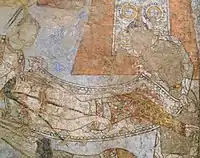 Injured Amazon carried on a stretched by two male attendants.
Injured Amazon carried on a stretched by two male attendants.
Ethnicities
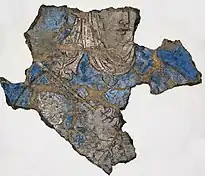 Wealthy Arab, Palace of Devashtich
Wealthy Arab, Palace of Devashtich Horsemen with pointed helmet.
Horsemen with pointed helmet.
See also
References
- Azarpay, Guitty; Belenickij, Aleksandr M.; Maršak, Boris Il'ič; Dresden, Mark J. Sogdian Painting: The Pictorial Epic in Oriental Art. University of California Press. p. 93. ISBN 978-0-520-03765-6.
- "PANJIKANT – Encyclopaedia Iranica". iranicaonline.org.
- Compareti, Matteo (2012). "Classical elements in Sogdian art: Aesop's fables represented in the mural paintings at Penjikent". Iranica Antiqua. XLVII: 303–316.
- Guides, Insight. Insight Guides Silk Road (Travel Guide eBook). Apa Publications (UK) Limited. p. 521. ISBN 978-1-78671-699-6.
- Rezakhani, Khodadad. ReOrienting the Sasanians: East Iran in Late Antiquity. Edinburgh University Press. p. 124. ISBN 978-1-4744-0030-5.
- "Hermitage Museum". Hermitage Museum.
- "It is possible that the Sogdian aristocratic culture of that time preserved some memory of the glorious days of Khingila, the first Hephthalite conqueror of India. The profile of Rustam, shown on different paintings at Pendzhikent, is very distinct from the other depictions in the Sogdian art, and resembles the Hephthalite prototypes. The portraits feature narrow skulls, V-shaped eyebrows, hooked noses and heavy jaws, and thus closely resemble some portraits of Khingila on the coins(Grenet 2002, 218-219)." Kurbanov, Aydogdy (2014). "THE HEPHTHALITES: ICONOGRAPHICAL MATERIALS" (PDF). Tyragetia: 317–334.
- Mode, Markus; Tubach, Jürgen; Vashalomidze, G. Sophia. Arms and Armour as Indicators of Cultural Transfer: The Steppes and the Ancient World from Hellenistic Times to the Early Middle Ages (in German). Reichert. p. 86. ISBN 978-3-89500-529-9.
- Kageyama (Kobe City University of Foreign Studies, Kobe, Japan), Etsuko (2007). "The Winged Crown and the Triple-crescent Crown in the Sogdian Funerary Monuments from China: Their Relation to the Hephthalite Occupation of Central Asia" (PDF). Journal of Inner Asian Art and Archaeology. 2: 20, drawing e. doi:10.1484/J.JIAAA.2.302540. S2CID 130640638.CS1 maint: multiple names: authors list (link)
- Also described in Marshak, Boris (1990). "Les fouilles de Pendjikent". Comptes rendus des séances de l'Académie des Inscriptions et Belles-Lettres. 134 (1): 298. doi:10.3406/crai.1990.14842.